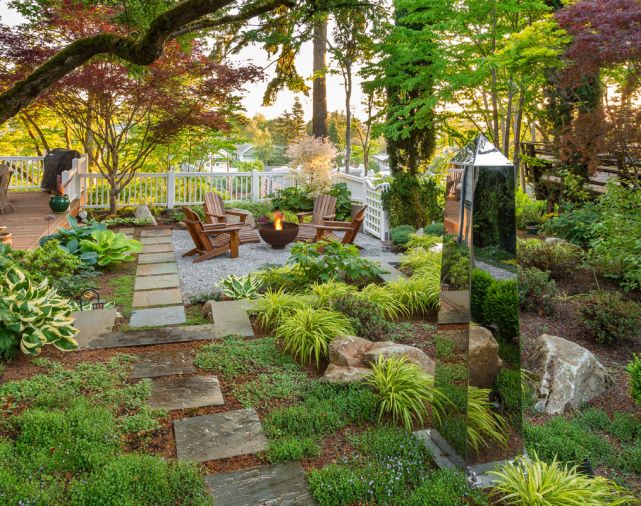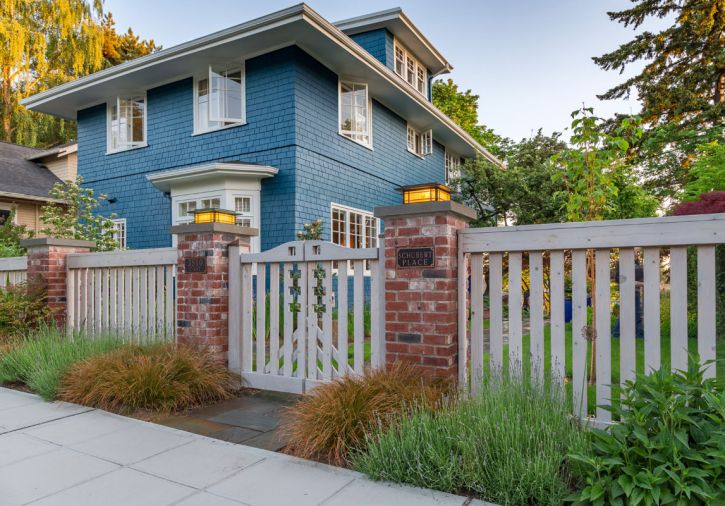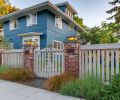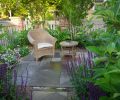When Brian Whiting looked around the yard of his Seattle home, he described it as a bit of a No Man’s Land: “There were random plantings, a play structure in a side yard, the fence needed to be repaired, and the walk to the front door needed to be more distinctive,” he recalls.
Whiting, who admits he enjoys plants but does not like maintenance, first thought of doing the landscape work himself as he had in previous homes. “I wanted to incorporate some of the plants I grew up with in Virginia including boxwood--my grandmother was editor of the Boxwood Bulletin for many years and has a cultivar named for her. And also rhodies/azaleas, dogwood/cornus, magnolia, day lilies, iris, daffodils, hostas, hydrangeas, maples, and various ornamental trees,” he says. “This time, though, I decided I could get someone else –someone who’s a pro and could just run with it.”
Armed with a list of plants and his goals for the area, he approached Michal Lehmann of Cambium Inc whose friends had referred him to and who coincidentally had designed some of the yards that Whiting admired most in his neighborhood.
“We were given a written statement of goals,” explained Lehmann. “There was to be a new fence and entry sequence, a sun garden with seating in the southwest yard, shaded garden seating with a water feature in the northeast corner, a small lawn area, and formal landscapes softened by more casual plantings. He wanted full lush color and a texture plus seasonal interest.”
Anchoring a home built in 1908, the 7500-square foot Seattle lot has a 50- by 15-foot south-facing front yard, and a 25- by 75-foot east-facing side yard. On the north side is a deck offering views of the area and a large steep slope that descends to the street below. The west side runs along the back of the lot and faces a neighboring home. As with many of the houses on the cul de sac, the home’s main entry doesn’t face the sidewalk, which made it all the more imperative to define the front entry way.
Lehmann started by assessing the existing trees and plantings: To be kept were a stand of mature big leaf maples, a large flowering crab apple tree and a few other trees to give the landscape needed height and maturity. Added in were the homeowner’s list of plants plus others Lehmann felt would most complement the garden.
Entry from the street is now easily identified by a front gate. Once in the gate, a bluestone path to the left leads to the private reading garden in the lot’s sunny southwest corner, while a wider bluestone walkway directs visitors to the front door. Lined on one side by a small lawn, at the front door the bluestone walk transitions into a path that heads to the yard’s more extensive woodland landscaping, a fire pit with a seating area, a water feature and finally the back deck.
“Even though it’s not a large, grand estate” said Lehmann, “we were able to fit in many interesting features. The client is a geologist so we felt it appropriate to incorporate stone textures into the garden. What resonates with me are the formal/informal contrasts that were asked for: the granite boulders contrast with the mirror polished steel obelisk, and the golden forest grass softens them both. Other contrasts are the formal alley maple trio in the informal crushed granite patio, which is backed by the clipped yew hedge. There is also a dwarf boxwood hedge that is kept pruned round not squared off, at the edge of the rectangular lawn and ashlar patterned bluestone path.”
Perhaps one of the garden’s most distinguishing features is the polished steel obelisk. Standing five feet tall, the sculpture reflects the shapes and colors of the plants around it in a modern interpretation of a Victorian gazing ball.
“The project surpassed my expectation and grew into something much better than I had ever expected,” adds Whiting. “It’s very functional and very enjoyable. It was a great project.”
Cambium Landscape Design
Cambium Landscape: Favorite Shade Picks
Trees
Acer circinatum - Vine Maple
There are some interesting cultivars such as ‘Pacific Fire’ (has red twigs) or ‘Pacific Purple’ (has purple leaves)
Acer palmatum
‘Ukigumo’, ‘Amber Ghost’, or ‘Shigitatsusawa’ - variegated leaf Japanese Maples
SHRUBS
Rhododendron ‘PJM Compacta’
(purple flowers in spring, burgundy leave blush in winter)
Fuchsia magellanica
‘Aurea’ or ‘Versicolor’
Hydrangea quercifolia
‘Munchkin’ (3’ - 4’ tall), ‘Snow Queen’ (4’ - 5’ tall) or ‘Alice’ (8’ - 15’ tall), also ‘Ruby Slipper’ has reddish flowers (to 4’ tall)
Cornus sanguinea ‘Midwinter Fire’
GRASSES + PERENNIALS
Hakonechloa macra ‘Aureola’
Carex oshimensis ‘EverColor Everillo’
Actaea simplex ‘Chocoholic’ or ‘Brunette’
Epimedium ‘Frohnleiten’
Epimedium x warleyense ‘Orange Queen’
Hosta ‘Guacamole’ (fragrant), ‘Patriot’ (white edged leaf), or ‘Krossa Regal’ (large, blue-green)
Astilbe ‘Fanal’
Helleborus foetidus ‘Wester Flisk’
Dicentra spectabilis ‘Gold Heart’ or ‘Valentine’
GROUNDCOVER
Pachysandra ‘Silveredge’
Vinca minor ‘Bowles’, or ‘Ralph Shugart’(Variegated leaf)
Cornus Canadensis
(groundcover dogwood)
Gautheria procumbens
(wintergreen flavored edible red berries)
Pratia pedunculata ‘County Park’
(sun and shade)
Soleirolia soleirolii ‘Aurea’














